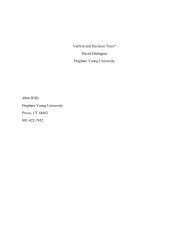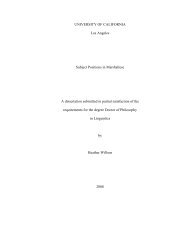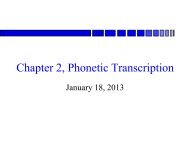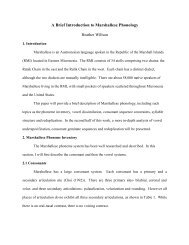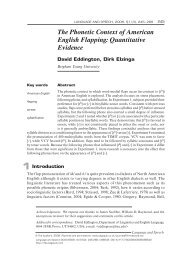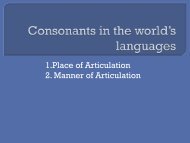Eddington, David. Spanish Phonology and Morphology ...
Eddington, David. Spanish Phonology and Morphology ...
Eddington, David. Spanish Phonology and Morphology ...
You also want an ePaper? Increase the reach of your titles
YUMPU automatically turns print PDFs into web optimized ePapers that Google loves.
<strong>Eddington</strong>, <strong>David</strong>. <strong>Spanish</strong> <strong>Phonology</strong> <strong>and</strong> <strong>Morphology</strong>. Experimental <strong>and</strong><br />
Quantitative Perspectives. Amsterdam: Benjamins. [Studies in Functional <strong>and</strong><br />
Structural Linguistics, Volume 53]. ISBN 9027215626. pp. xv + 197.<br />
Reviewed by Michael Cysouw<br />
Max Planck Institute for Evolutionary Anthropology, Leipzig.<br />
Over the last decade, <strong>David</strong> <strong>Eddington</strong> has produced a long series of articles,<br />
published in various journals (including this journal), approaching the structure of the<br />
<strong>Spanish</strong> language from a quantitative perspective. The book presently under review is<br />
a summary of this work, put it into context with other related publications. This book<br />
is very well written, in a clear style <strong>and</strong> with a good balance between detail <strong>and</strong><br />
survey. The book should be particularly appealing to advanced students of <strong>Spanish</strong><br />
linguistics <strong>and</strong> to researchers working on <strong>Spanish</strong> that would like to start using<br />
experimental methods. However, for experienced experimentally driven researchers<br />
this book will not have much to offer, except for the presentation of some lesser<br />
known quantitative studies of the structure of <strong>Spanish</strong>, published in not widely<br />
available <strong>Spanish</strong> journals or conference proceedings.<br />
It is a pity that it is not made clear at the outset what kind of book this is. I<br />
have to stress that E’s research is of good quality, <strong>and</strong> his various papers are<br />
worthwhile additions to the experimental study of language. However, the current<br />
monograph really only makes sense as an introductory textbook to quantitative <strong>and</strong><br />
experimental work, using <strong>Spanish</strong> as an exemplary language. Most chapters present<br />
nice succinct surveys over a particular topic, but there is neither new research, nor any<br />
in-depth review a particular field of research. Also, I am missing the coherence<br />
among the chapters: they have more of an exemplary character, which is exactly right<br />
for a textbook, though somewhat dissatisfying as a scientific monograph.<br />
The first two chapters present a quick discussion of some philosophical <strong>and</strong><br />
methodological questions concerning the empirical basis of linguistic research. In the<br />
first chapter, E gives an exposition of why he is dissatisfied with Chomskyan-type<br />
formal approaches to language. He summarises that such approaches are ‘primarily<br />
based on internal evidence, utilize autonomous methodologies <strong>and</strong> are non-empirical
in nature’ (17). As a result of such deficiencies, E argues that the psychological<br />
significance of the resulting linguistic analyses is doubtful, in contrast to what is<br />
normally claimed by Chomsky <strong>and</strong> his followers. In the second chapter, the usage of<br />
psycholinguistic experiments is proposed as a more suitable method to reach<br />
psychologically significant theories. The central section of this chapter is section 2.3<br />
(27-35) in which E discusses various criticisms of the experimental approach.<br />
However, this discussion is too short <strong>and</strong> general to convince those who do not<br />
believe in it, <strong>and</strong> those who accept the validity of experimental work will not find any<br />
new arguments. Overall, my impression of these first two chapters is one of a battle<br />
against a straw man. It is undeniable that Chomskyan-type formal analyses have had a<br />
strong impact on the methods used to study language. However, currently there is<br />
wide diversity of methods <strong>and</strong> approaches to be found in he field, <strong>and</strong> each of these<br />
subfields have their own community with conferences, journals <strong>and</strong> email-lists. E’s<br />
statement that ‘most contemporary analyses of language are formal’ (17) does not<br />
correspond to my impression of contemporary linguistics. It does not appear to be<br />
necessary anymore to assure the superiority of one approach over the other. The<br />
different approaches should try to show their utility by presenting interesting results –<br />
<strong>and</strong> E will do just this for his experimental approach in the remainder of this book.<br />
The first two chapters could easily have been left out.<br />
Chapters three to seven discuss a highly diverse set of investigations into<br />
linguistic structure – diverse both from a methodological <strong>and</strong> a linguistic point of<br />
view. Linguistically, examples from <strong>Spanish</strong> phonology <strong>and</strong> morphology (as<br />
announced in the title of the book) are used without any order or cross-referencing<br />
between them. The structure of the book is clearly not governed by content, but by<br />
methodological issues. Methodologically, chapter three highlights the usage of<br />
questionnaires; chapter four focuses on corpus counts; chapter five mostly presents<br />
results from simulations <strong>and</strong> chapter seven uses results from lexical decisions tasks.<br />
Chapter 6 falls out of this structure, as there are various methods used, but<br />
linguistically they all deal with <strong>Spanish</strong> phonology. However, there are many<br />
phonological issues discussed in other chapters as well, so the selection of the issues<br />
for this chapter appears to be guided by yet another principle: ‘the processes of<br />
diphthongization, syllabification, <strong>and</strong> stress assignment have held a prominent<br />
position in the literature of <strong>Spanish</strong> phonology. … A discussion of these processes, to<br />
the exclusion of others, is included in this chapter simply because they have been
most studied from an empirical st<strong>and</strong>point’ (99). I will now discuss each of these<br />
chapters separately<br />
In chapter three, E summarises a few examples from <strong>Spanish</strong> phonology (s-<br />
deletion, secondary stress placement, coronal/velar softening, depalatization,<br />
intonation) where experimental work, not performed by E himself, has shown that<br />
generalisation proposed by formal linguists are not satisfying when more data <strong>and</strong><br />
psycholinguistic experiments are taken into account. All these individual examples<br />
are highly interesting, though simply drawn directly from the published literature <strong>and</strong><br />
discussed separately without showing any interrelation between them. The only<br />
coherence linking these examples is the fact that the experimental research challenges<br />
earlier generalisations. The chapter finishes (54-57) with a summary of E’s own work<br />
on the usage of ‘change-of-state verbs’ in <strong>Spanish</strong> (llegar a ser, ponerse, volverse,<br />
quedarse, convertirse, transformarse, hacerse). This is also a highly interesting topic,<br />
<strong>and</strong> E shows convincingly that the traditional generalisations do not hold under<br />
scrutiny. However, except for this point, there is no relation to the other topics<br />
discussed in this chapter. First, we are suddenly in the field of lexical semantics<br />
instead of phonology. Second, the existing generalisation against which E argues in<br />
this work are generalisations proposed by traditional <strong>Spanish</strong> philologists, not by<br />
formal Chomskyanists, as was the case for the earlier examples in this chapter.<br />
In the rather short chapter four, E discusses some examples showing that<br />
frequency is important in explaining linguistic phenomena. Linguistically, the<br />
structure of this chapter is as unconstrained as the previous. A few examples are<br />
presented from the published literature, dealing with highly different linguistic areas<br />
(voicing of plosives, agreement in imperatives, intervocalic d-deletion, collocation<br />
frequency), all of which can be interpreted as showing that the earlier proposed<br />
generalisations interact with frequency of occurrence. Further, E cites his own<br />
research on vowel epenthesis before <strong>Spanish</strong> initial sC- clusters (63-66). In<br />
loanwords, like scanner or stress, <strong>Spanish</strong> speakers invariably epenthesise e- to such<br />
clusters, although in native <strong>Spanish</strong> lexemes all other vowels are also found (e.g.<br />
asbesto, oscilar, istmo). E argues that the high frequency of esC- clusters is the reason<br />
for the usage of e- in new words. As can be seen from his corpus counts, it could be<br />
both token or type frequency that could drive this generalisation (both show the same<br />
5 to 1 skewing in the usage e- versus the other vowels). However, E does not discuss<br />
why this frequency-based explanation is better than the explanation that would be
ventured by formal Chomskyan linguists, namely that there is only one productive<br />
pattern.<br />
In chapter five, a different quantitative approach is introduced: simulations<br />
based on analogical modelling. The examples using this approach for the <strong>Spanish</strong><br />
language are all based on E’s own work (on gender assignment, nominalisations <strong>and</strong><br />
diminutives). The assignment of gender by analogical modelling reached a 95.5%<br />
success rate, which is extremely high. However, using the pedagogical rule saying<br />
that all words are masculine except when ending in -a, -d, -ción, -sión, -tis <strong>and</strong> -sis,<br />
also results in 95% correct assignments (80-81). However, as E notes himself, such<br />
results are no criticism on formal generative approaches, because they never were<br />
designed to predict performance. ‘They strive to describe gender in terms of a rule<br />
system that derives a word’s final phoneme(s) given the word’s inherent gender <strong>and</strong> a<br />
set of abstract assumptions about the word’s underlying structure. In other words,<br />
they are not designed to predict a word’s gender given its phonological properties’<br />
(80). In another study, the model correctly predicted the form of 91% of the<br />
nominalizations ending in -ión. Even more interesting, half of the wrongly predicted<br />
forms were actually encountered on <strong>Spanish</strong> internet pages (92-93). This chapter is<br />
really a fine showcase for the usefulness of analogical modelling to predict linguistic<br />
structures.<br />
Chapter six discusses three themes that have been most studied from an<br />
empirical st<strong>and</strong>point: diphthongization (alternations in <strong>Spanish</strong> like cuento-<br />
contamos), the psycholinguistic impact of syllable structure, <strong>and</strong> stress assignment. E<br />
himself has published on diphthongization <strong>and</strong> stress assignment. Relating to<br />
diphthongs, E has investigated the influence of nominal derivational suffixes on<br />
diphthongization by way of corpus study <strong>and</strong> the usage of questionnaires (103-105).<br />
He has shown that there are some suffixes that almost always require a diphthong in<br />
the root (-ito, zuelo, -illo, -ísimo, -azo), some that almost never allow<br />
diphthongization (-ero, -al, -dad) <strong>and</strong> some that are somewhere in-between (-oso, -<br />
ista). There seems to be a correlation with productivity, viz. the more productive<br />
suffixes require diphthongization, though E does not venture further into this possible<br />
correlate <strong>and</strong> its interpretation. Relating to stress assignment, E has shown that an<br />
analogical model can correctly predict 94% of the stress placements, including 40%<br />
correct of the words with stress on the antepenultimate, which are notoriously difficult
for any generalisation, <strong>and</strong> have to be lexically stipulated in most analyses (118-119).<br />
This is also a stupendous result urging more research in this framework.<br />
Chapter seven focuses on results from lexical decision tasks in relation to<br />
priming, a classical psycholinguistic method. A few studies are summarised that show<br />
that a strong morphological priming effect exists for <strong>Spanish</strong>, independently from<br />
orthographic <strong>and</strong> semantic relationships. By using this effect, it has been shown that<br />
the apparently regular gender suffixes -a <strong>and</strong> -o are not processed as morphological<br />
separate entities, but that word-pairs like hermano <strong>and</strong> hermana are stored separately.<br />
In contrast, there is evidence that the plural suffix -s is used as a separate morpheme.<br />
However, recent research, including some work by E himself, has cast doubt on this<br />
result, because the corpus frequency of the words also appears to be of influence as<br />
well.<br />
Finally, an extremely short concluding chapter is followed by a very useful<br />
guide to some experimental methods <strong>and</strong> their quantitative evaluation. This guide<br />
once again reinforces the impression that this book was planned to be usable as<br />
textbook or introduction for non-empirical researchers. The guide is detailed enough<br />
to underst<strong>and</strong> the basic idea behind the various approaches <strong>and</strong> can function nicely as<br />
an introductory statement into quantitative methods. However, to actually start<br />
performing such analyses more specialised literature should be used.<br />
In summary, this book is highly valuable as a textbook or introductory text. It<br />
also gives a nice showcase of the application of various quantitative methods on a<br />
language different from English. The results of the many studies that are discussed in<br />
the book are highly interesting <strong>and</strong> truly deserve more attention than they seem to get<br />
outside the close circle of empirical investigators of <strong>Spanish</strong>. My main reservations<br />
about this book concern its somewhat haphazard structure, which is not suitable for a<br />
monograph, <strong>and</strong> the fact that there is no new research reported. The book is more like<br />
a research review that became too long to be published as a journal article, <strong>and</strong> has<br />
subsequently been extended by the introductory first two chapters <strong>and</strong> a<br />
methodological appendix to reach the desirable book-length.





